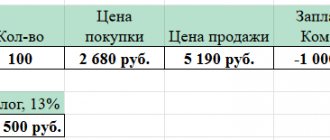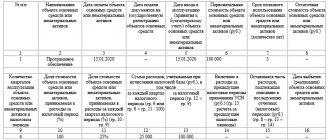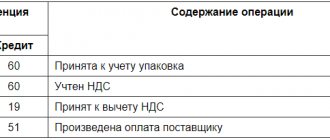Trademark as an intangible asset
Every year, more and more companies make a conscious choice to register a trademark as a means of recognition and attracting customer attention. A trademark, being an intangible asset, is part of the property of a legal entity, which will increase its value if a decision is made to sell the enterprise. And like any property, a trademark can be sold to pay off a debt or it can be foreclosed on by the bailiff service. According to a commentary from the legal portal www.law-consult.ru, during the bankruptcy procedure of a legal entity or individual entrepreneur, the trademark is included in the bankruptcy estate for subsequent evaluation and sale. The difficulties of registering a trademark lie in the correct determination of its initial value and correct taxation. In this article we will analyze in detail how a trademark can be acquired and tell you how to evaluate a trademark, accept it on the balance sheet of an organization and take into account VAT.
Since a trademark is an intangible asset, in accounting and tax accounting, in accordance with clause 5 of PBU 14/2007 “Accounting for intangible assets,” the right to this trademark is taken into account, regardless of the method of its acquisition.
Termination of exclusive rights to a trademark
When transferring exclusive rights to a new owner (sale of a trademark, transfer for free use), this must be reflected in accounting and tax records. In this case, the residual value can be taken into account as an expense. For example, let's return to, which sells the rights to its mark for 100,000 rubles (excluding VAT). Depreciation at the time of transfer of rights amounted to 40,000 rubles. Then the report will look like:
| Contents of operation | Debit | Credit | Amount, rub. |
| Write-off of original cost | 04 | 04 | 125 000 |
| Depreciation | 05 | 04 | 40 000 |
| Income from the sale of rights is recognized | 76 | 91-1 | 118 000 |
| Residual value on balance sheet “X” | 91-2 | 04 | 85 000 |
| VAT | 91-3 | 68 | 18 000 |
| Receipt of funds to the current account | 51 | 76 | 118 000 |
Initial cost of the trademark
An accountant accepts a trademark at its original cost, the formation of which directly depends on how it was acquired. Let's consider all the options:
1 When creating a trademark yourself, subaccount 08-5 “Acquisition of intangible assets” will accumulate expenses that make up the initial cost of the trademark. Here we will include the following expenses: wages of employees directly involved in the creation of a trademark with accruals, materials used in the development of the trademark, as well as the amount of expenses associated with registering the trademark. After receiving a certificate for a trademark, the expenses that formed its initial cost in subaccount 08-5 will be written off to account 04 “Intangible assets”.
Example. Vesta LLC registers a trademark created independently. An employee of Vesta LLC, Petrov, developed a trademark as part of his job duties. Vesta LLC applied to Rosreestr to register a trademark, paying the state fee.
The following entries will be reflected in the accounting records:
|
2 If a trademark is purchased from the copyright holder, then subaccount 08-5 “Acquisition of intangible assets” will reflect amounts directly related to the costs of acquiring the trademark. For example, to such expenses we will include the amount paid to the copyright holder, expenses for payment of intermediary, consulting, information services if they relate to a trademark, and state fees.
Example. LLC "Gamma" acquired the trademark under an agreement on the alienation of the exclusive right from LLC "Voskhod", and also turned to LLC "Vesna" for consulting services on the registration of the trademark. Gamma LLC paid a state fee for registering a trademark.
The accounting records of Gamma LLC will reflect the following entries:
|
3 The acquisition of the right to use a trademark under a license agreement determines a special procedure for registering a trademark. A trademark received for temporary use is taken into account by both the licensee (user) and the copyright holder.
The user takes into account the existence of the right to the mark in the off-balance sheet account. Depreciation is accrued only by the copyright holder (licensor). Accounting for the right to use a trademark depends on the terms of payment (one-time or periodic payments) and the type of activity of the organization.
If the license agreement provides for a one-time payment (lump sum payment) for the use of a trademark, then the payment amount is taken into account as deferred expenses and is written off evenly over the term of the agreement. Periodic payments (royalties) are taken into account by the user of the trademark as expenses of the reporting period.
4 A trademark can be obtained free of charge, but this also requires an assessment of its value and acceptance on the balance sheet. In this case, the value of the trademark must be determined either independently, based on the cost for which this trademark could be sold or use the services of an appraiser, as required by clause 23 of the Regulations on Accounting and Financial Reporting, clause 13 of the PBU 14/2007. Accounting for a gratuitously transferred trademark can cause difficulties due to different initial costs for accounting and tax purposes.
The cost of a trademark received free of charge is recognized as other income of the organization (clause 7 of PBU “Income of the organization” 9/99) and is taken into account in account 98 “Deferred income”. Further, the initial cost of the trademark will be depreciated and written off as other income for the current period.
Example. LLC "Omega" received a trademark free of charge, paid the state duty for registration actions in Rosreestr. The assessment was carried out with the assistance of an appraiser. The useful life of the trademark is 10 years (120 months), with depreciation calculated using the straight-line method.
Omega LLC will reflect the following accounting entries:
|
When accepting a trademark received free of charge on your balance sheet, it is necessary to control its tax accounting, since only the actual expenses incurred will be included in the cost of the trademark. In our example, these are the costs of the appraiser’s services and the amount of state duty.
Every month, when depreciation is calculated, a constant difference and a constant tax liability will arise, since the cost of the trademark in accounting will exceed its tax value.
In accounting and tax accounting, the moment of income recognition will be different. In accounting, such income will be taken into account gradually, with depreciation. Tax accounting recognizes income at once. As a consequence, a deductible temporary difference and a deferred tax asset will arise in accounting.
5 A trademark can be included in the authorized capital. In accounting, the value of a trademark will be determined by the amount of valuation of a specific trademark by all founders of the organization. For tax accounting, a trademark must be accepted at the residual value indicated in the founder’s reporting documents. At the same time, in accordance with clause 1 of Article 277 of the Tax Code of the Russian Federation, if an organization cannot document the value of a trademark, then its value for tax accounting purposes is recognized as zero.
Example. The founder of Vesna LLC contributed a trademark as a contribution to the authorized capital.
The organization will reflect the following transactions:
|
Today, many companies do not take trademarks into account on their balance sheets, attributing this, first of all, to the complexities of accounting and tax accounting. Lawyer Orlovskaya K.V., specializing in the field of tax law, copyright and related rights, believes that the importance of correctly determining the value of a trademark is the key to a successful tax policy. Companies that have trademarks in their reserves can ensure the identification of significant tax reserves for value added tax and income tax.
Costs for using a trademark
Expenses for the use of a trademark (TK received under license agreements, commercial concession agreements) are reflected depending on the procedure for paying fees for the right to use the TK (clause 39 of PBU 14/2007):
- In case of one-time payment as deferred expenses.
- For periodic payments - as current expenses.
The cost of the technical knowledge received for use is taken into account on the balance sheet. There is no separate account for such assets in the chart of accounts. It is recommended to create an off-balance sheet account yourself, for example, the “Intangible assets received for use” account.
Typical accounting entries for this case are shown in Table 2.
Accounting table
| No. | Contents of accounting entries | Accounts | |
| Debit | Credit | ||
| 1 | The cost of the received technical specifications is reflected | 012 “Intangible assets received for use” | |
| 2 | Expenses of future periods are reflected (one-time payment for the rights to use technical knowledge) | 97 | 60 (76…) |
| 3 | Reflects periodic payments for the right to use technical knowledge | 20 (26, 44…) | 60 (76…) |
| 4 | VAT on expenses associated with the use of the right to trademark. | 19 | 60 (76…) |
| 5 | Write-off of future expenses for current expenses (in accordance with accounting policies, usually monthly) | 20 (26, 44…) | 97 |
Value added tax
As a general rule, the amounts of expenses, for the purpose of forming the initial cost of a trademark, are displayed excluding VAT and other refundable taxes.
For an organization that is not a VAT payer, by virtue of clause 2 of Article 170 of the Tax Code of the Russian Federation, the amount of “input” VAT is taken into account in the cost of the trademark.
If the trademark is used in activities subject to VAT, then the amount of VAT presented by counterparties for services constituting the initial cost of the trademark is reflected in the debit of account 19 “Value added tax on acquired assets.” This amount of VAT can be deducted after the trademark is registered as an intangible asset by writing off the VAT amount to the debit of account 68 “Calculations for taxes and fees” from the credit of account 19.
How is it recorded in the book? accounting?
Costs of registration in 1C
To reflect the accounting of a trademark in accounting and tax accounting, the following typical entries are most often used:
loss
| Dt | CT | Contents of operation |
| 08 | 60 | Purchase a trademark |
| 19 | 60 | VAT |
| 60 | 51 | Cost paid |
| 04 | 08 | The trademark is accepted as an intangible asset |
| 68 | 19 | VAT on the trademark is accepted for deduction |
How can a trademark become part of a company's assets? If an enterprise (entrepreneur) creates a trademark through its own efforts, then the cost must include:
- material losses (directly for creation);
- labor costs (salaries and wage accruals for employees who developed the emblem);
- other expenses (all other expenses that do not fit into the previous categories, for example, various consulting and legal services, taxes, duties, etc.).
In this case, the initial cost is formed in a subaccount called “Acquisition of intangible assets.”
The business transaction log in this case will look like this:
- accrued salary to the employee: Dt “Purchase of intangible assets” Kt “Settlements with personnel for wages”;
- insurance premiums were accrued from the employee’s salary: Dt “Acquisition of intangible assets” Kt “Calculations for taxes and fees”, “Calculations for social insurance and security”;
- the amount of the duty is taken into account: Dt “Acquisition of intangible assets” Kt “Settlements with various debtors and creditors”;
- the fee has been paid: Dt “Settlements with various debtors and creditors” Kt “Settlement accounts”.
These expenses are written off in full from the sub-account “Acquisition of intangible assets” to the active account “Intangible Assets” after receiving the document fixing the right.
You can find out about the cost of registering a trademark here, and read about the application for registration of a trademark in this material.
What documents are used to transfer rights to use?
Upon transfer, one of the following documents is drawn up:
- a license agreement that confirms the right of temporary use by another enterprise (entrepreneur) on pre-agreed conditions and for a specified period;
- assignment agreement, which confirms the fact of transfer of ownership to another person.
The transfer is completed as follows:
loss
| Debit | Credit | Contents of operation |
| 51 | 76 | Receiving an advance under a concluded agreement |
| 76 | 68.2 | VAT on the advance received |
| 76 | 91.1 | Royalty received |
| 20 | 05 | Depreciation accrued |
Trademark depreciation
The trademark is subject to depreciation. The method of calculating depreciation (linear or non-linear) is established by the accounting policy of the organization and cannot be changed during the entire period of use of the trademark. Depreciation is not charged on a trademark owned by a non-profit organization (clause 24 of PBU 14/2007).
The amounts of accrued depreciation can accumulate on account 05 “Amortization of intangible assets” or reduce the amount of the initial cost of the trademark on account 04 “Intangible assets”.
The useful life of a trademark as an intangible asset is defined by Article 258 of the Tax Code of the Russian Federation and can be determined in three ways: as the validity period of the trademark registration certificate, as the useful life defined in the contract, or the useful life is set equal to 10 years.
The useful life of the trademark determined in this way must be reduced by the time spent to obtain a certificate for the trademark.
That is, if the useful life is 10 years and the time spent on obtaining the certificate is 8 months, the useful life for calculating depreciation will be equal to 9 years 4 months.
When using a trademark in the sale or production of goods (work, services), the amount of accrued depreciation, in accordance with clause 2 of Article 253 of the Tax Code of the Russian Federation, is included in the costs associated with production and sales. Article 1484 of the Civil Code of the Russian Federation defines the following methods of using a trademark:
|
If an organization has acquired the exclusive right to a trademark for the purpose of its further resale and does not use this trademark in the sale or production of goods (work, services), depreciation is not accrued on such an object. Such a trademark must be accounted for as a product and the proceeds from the sale of the trademark can be reduced by the amount of its cost (clause 2, clause 1, article 268 of the Tax Code of the Russian Federation). This is also evidenced by the letter of the Ministry of Finance of Russia dated July 29, 2004 No. 07-05-14/199, the letter of the Federal Tax Service of Russia for Moscow dated April 7, 2005 No. 20-12/23565.
Decommissioning of a trademark
A trademark as an intangible asset, with the exception of a trademark received for use, can be written off from accounting in the following cases:
|
The amount of the cost of the trademark and the amount of accrued depreciation are written off from the corresponding accounting accounts to the financial results of the organization (other income or expenses).
The article was prepared by the legal portal www.law-consult.ru Read about Bankruptcy of Individuals here.







